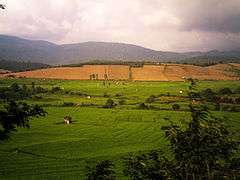Mazandaran Province
| Māzandarān Province استان مازندران | |
|---|---|
| Province | |
|
| |
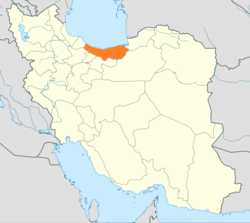 Location of Mâzandarân within Iran | |
| Coordinates: 36°33′56″N 53°03′32″E / 36.5656°N 53.0588°ECoordinates: 36°33′56″N 53°03′32″E / 36.5656°N 53.0588°E | |
| Country |
|
| Region | ONE 1 [1] |
| Capital | Sari |
| Counties | 22 |
| Area[2] | |
| • Total | 23,833 km2 (9,202 sq mi) |
| Population (2011)[3] | |
| • Total | 3,073,943 |
| • Density | 130/km2 (330/sq mi) |
| Time zone | IRST (UTC+03:30) |
| • Summer (DST) | IRST (UTC+04:30) |
| Main language(s) | Persian[4] |
Mazandaran Province ![]() pronunciation , (Persian: استان مازندران Ostān-e Māzandarān/Ostâne Mâzandarân), is an Iranian province located along the southern coast of the Caspian Sea and in the adjacent Central Alborz mountain range, in central-northern Iran.[5]
pronunciation , (Persian: استان مازندران Ostān-e Māzandarān/Ostâne Mâzandarân), is an Iranian province located along the southern coast of the Caspian Sea and in the adjacent Central Alborz mountain range, in central-northern Iran.[5]
Introduction
Mazandaran Province is one of the most densely populated provinces in Iran[6] and has diverse natural resources, notably large reservoirs of oil and natural gas.[7] The province's four largest counties are Sari, Amol, Nur, and Tonekabon.[8] It was founded in 1937.[9]
The diverse nature of the province features plains, prairies, forests and rainforest[10] stretching from the sandy beaches of the Caspian Sea to the rugged and snowcapped Alborz sierra,[11] including Mount Damavand, one of the highest peaks and volcanos in Asia.[12]
Mazandaran is a major producer of farmed fish,[13] and aquaculture provides an important economic addition to traditional dominance of agriculture.[14] Another important contributor to the economy is the tourism industry, as people from all of Iran enjoy visiting the area.[15] Mazandaran is also a fast-growing centre for biotechnology.[7]
Administrative divisions
The province covers an area of 23,842 km².[16] Sari is the capital city of the province.
Mazandaran is divided into 15 counties (shahrestan in Persian). All the shahrestans are named after their administrative center, except Savadkooh.
History
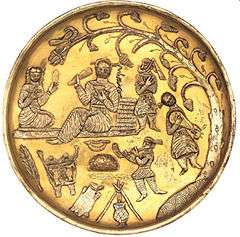
Human habitation in the area dates back at least 75,000 years.[17] Recent excavations in Goher Tippe provide proof that the area has been urbanized for more than 5,000 years, and the area is considered one of the most important historical sites of Iran.[18] It has played an important role in cultural and urban development of the region.[19]
Indigenous peoples of the region include the ethnic Mazanderanis,[20] who speak an Iranian language which most closely resembles Gilaki and Sangiseri language, but also has phono-typical similarities to several Caucasian languages, reflecting the history of the region and its peoples.
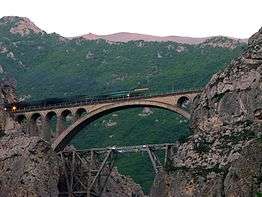
In the early 20th century, Reza Shah connected northern Elbourz to the southern slopes by constructing seven new roads and railways, the provinces of Mazandaran and Gilan became known as Shomal by all Iranians (meaning "the North" in Persian). Mazandaran is a Caspian province in the north of Iran.[21] Located on the southern coast of the Caspian Sea, it is bordered clockwise by Russia (across the sea), Golestan, Semnan, Tehran, Alborz, Qazvin, and Gilan provinces. Sari is the largest city and the capital of Mazandaran province.
Mazandaran Province was made part of the First Region upon the division of the provinces into five regions solely for coordination and development purposes on June 22, 2014.[1]

Discoveries
Scientific discoveries in the caves of Hutu and belt, a testament to the life of 75 thousand years ago have been found . Mythical land Iran of Mazandaran is an nd dating life in the Medians have said . Mazandaran the oldest human settlements in the Iran.
Pre-Islamic history
| Part of a series on the History of Tabaristan |
|---|
|
Ancient periods paces
|
|
Sasani Houses |
|
Sasani period |
|
Shi'a period
|
|
Modern period
|
|
Before the arrival of the Iranian-speakers to Iran, native people of this area were subsistence hunters and cattle herders. Archaeological studies in caves belt and Hutu man in Behshahr in the Mazandaran date to approximately 9500 BC. Aryan migration from the north-eastern borders of modern Iran began around the third millennium BC, mixed with the natives. The Amardids were a tribe living along the mountainous region bordering the Caspian Sea, including current day Amol.
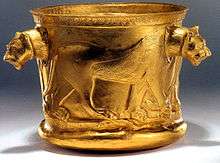
The Aryan people and Scythian tribes before the arrival of the next group, the Aryans, Medes, Persians, and Parthians lived in a part of the current Caspian. The region is known to have been populated from early antiquity, and Mazandaran has changed hands among various dynasties from early in its history. There are several fortresses remaining from Parthia and Sassanid times, and many older cemeteries scattered throughout the province. During this era, Mazandaran was part of Hyrcania Province which was one of the important provinces.
With the advent of the Sassanid dynasty, the King of Mazandaran (Tabaristan and Padashkhwargar) was Gushnasp,[22] whose ancestors had reigned in the area (under the Parthian empire) since the time of Alexander the Great. In 529–536, Mazandaran was ruled by the Sassanid prince Kawus, son of Kawadh.[22] Anushirawan, the Sassanid king, defeated Zarmihr, who claimed his ancestry from the legendary blacksmith Kaveh.[22] This dynasty ruled the area till 645 AD, when Gil Gilanshah (a descendant of the Sassanid king Jamasp and a son of Piruz) joined Mazandaran to Gilan.[22]
Post-Islamic history
During the post-Islamic period the local dynasties fell into three classes: local families of pre-Islamic origin; the ʿAlid sayyid; and local families of secondary importance.[22]

The Bawandids, who claimed descent from Kawus, provided three dynasties.[22] The first dynasty (665–1007) was overthrown on the conquest of Tabaristan by the Ziyarid Kabus b. Wushmgir.[22] The second dynasty reigned from 1073 to 1210, when Mazandaran was conquered by 'Ala al-Din Muhammad Khwarzamshah.[22] The third ruled from 1237 to 1349 as vassals of the Mongols.[22] The last representative of the Bawandids was killed by Afrasiyab Chulawi.[22]
The Karinids claimed descent from Karin, brother of Zarmihr who was the pre-Islamic ruler under the Sassanids.[22] Their last representative Mazyar was put to death in 839.[22]
The Paduspanids claimed descent from the Dabyuids of Gilan.[22] They came to the front about 660 and during the rule of the ʿAlids were their vassals. Later, they were vassals of the Buyids and Bawandids, who deposed them in 1190.[22] The dynasty, restored in 1209-10, survived till the time of Timur; the branch descended from Kawus the son of Kayumarth reigned till 1567 and the other, that of Iskandar the son of Kayumarth, till 1574.[22]
In the 9th-11th century AD, there were repetitively military raids undertaken by the Rus' between 864 and 1041 on the Caspian Sea shores of Iran, Azerbaijan, and Dagestan as part of the Caspian expeditions of the Rus'.[23] Initially, the Rus' appeared in Serkland in the 9th century traveling as merchants along the Volga trade route, selling furs, honey, and slaves. The first small-scale raids took place in the late 9th and early 10th century. The Rus' undertook the first large-scale expedition in 913; having arrived on 500 ships, they pillaged the westernmost parts of Gorgan as well as Mazandaran and Gilan, taking slaves and goods.
In the Safavid era Mazandaran was settled by very large amounts of Georgians, Circassians, Armenians, and other Peoples of the Caucasus, whose descendants still live or linger across Mazandaran. Towns, villages and neighbourhoods in Mazandaran still bear the name "Gorji" (i.e., Georgian) in them, although most of the large amounts of Georgians, and Circassians are already assimilated into the mainstream Mazandaranis. The history of Georgian settlement is described by Iskandar Beg Munshi, the author of the 17th century Tarikh-e Alam-Ara-ye Abbasi, and both the Circassian and Georgian settlements by Pietro Della Valle, among other authors.[24]
Before the reign of Nader Shah, the province was briefly occupied by the Russian army in the aftermath of the Russo-Persian War (1722–23) and returned to Persia in 1735. Following the outcomes of the Russo-Persian War (1804–13) and the Russo-Persian War (1826–28) Russian influence in northern Iran, and especially Mazandaran and Gilan.
Modern era
Tapuria remained independent until 1596, when Shah Abbas I, Mazandarani on his mother's side, incorporated Mazandaran into his Safavid empire, forcing many Armenians, Circassians, Georgians, Kurds and Qajar Turks to settle in Mazandaran. Pietro della Valle, who visited a town near Pirouzcow in Mazandaran, noted that Mazandarani women never wore the veil and didn't hesitate to talk to foreigners. He also noted the extremely large amount of Circassians and Georgians in the region, and that he had never encountered people with as much civility as the Mazandaranis.
Today, Persia proper, Fars, Mazanderan on the Caspian Sea and many other lands of this empire are all full of Georgian and Circassian inhabitants. Most of them remain Christian to this day, but in a very crude manner, since they have neither priest nor minister to tend them.
After the Safavid period, the Qajars began to campaign south from Mazandaran with Agha Mohammad Khan who already incorporated Mazandaran into his empire in 1782. On 21 March 1782, Agha Mohammad Shah proclaimed Sari as his imperial capital. Mazandaran was the site of local wars in those years, which led to the transfer of the capital from Sari to Tehran by Fath Ali Shah. In Modern era at Mazandaran make new house and bridge in Amol and Sari.
Geography and population

Geography
Mazandaran is located on the southern coast of the Caspian Sea. It is bordered clockwise by Golestan, Semnan and Tehran provinces.[25] This province also borders Qazvin and Gilan to the west. Mazandaran province is geographically divided into two parts: the coastal plains, and the mountainous areas. The Alborz Mountain Range surrounds the coastal strip and plains of the Caspian Sea. From the geographical point of view, Mazandaran province is divided into two parts i.e. coastal plain and the mountainous area. The Alborz Mountain Range like a huge wall has surrounded the coastal strip and plains of the Caspian Sea. Due to permanent sea breez and local winds of the southern and eastern coasts of the Caspian Sea, sandy hills are formed, causing the appearance of a low natural barrier between the sea and plain. There is often snowfall in the Alborz regions, which run parallel to the Caspian Sea's southern coast, dividing the province into many isolated valleys. The province enjoys a moderate, subtropical climate with an average temperature of 25 °C in summer and about 8 °C in winter. Although snow may fall heavily in the mountains in winter, it rarely falls at sea level.
Ecoregions:
Environment
Caspian tiger and Caspian horse two animals that came from Mazandaran. Ramsar Convention also held in Mazandaran.
 |
Caspian Sea | Caspian Sea | Caspian Sea |  |
| Gilan Province Qazvin Province | |
Golestan Province | ||
| ||||
| | ||||
| Alborz Province | Tehran Province | Semnan Province |
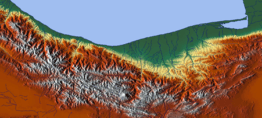
Unlike the rest of Persia, Mazanderan is watered by numerous rivers, or mountain torrents, all running from the mountains to the sea . The German traveller Gmelin, who visited this country a. d. 1771, says that in the space of eight miles, on the road from Resht to Amot, 250 of such streams are to be seen, many of them being so exceedingly broad and deep, that the passage across is sometimes impracticable for weeks together.
Climate
Mazandaran province naturally comes under the influence of the geographical latitude, Alborz heights, elevation from sea level, distance from the sea, and the southern barren areas of Turkmenistan, local and regional air currents, and versatile vegetation cover. Therefore, prompting the climate of the province to be divided into three types : Moderate Caspian weather with hot, humid summers, and mild, humid winters. Moderate mountainous weather with long, cold, and freezing winters and mild and short summers, and cold mountainous weather with long freezing winters and short cool summers. There is often snowfall during most of the seasons in the latter region, which continues till mid summer.
Climate
It has a variety of climates, including the mild and humid climate of Caspian shoreline and the moderate and cold climate of mountainous regions.

The western and central plains of the province, up to the northern foothills of Alborz Mountain Range, experience the mild climate of the Caspian region. In the 1,500- to 3,000-meter altitudes, there is a moderate mountainous climate, with long, cold winters, and short, mild summers. In this region, snow covers parts of the province even up to the middle of the warm season. In fact, snow can be observed in this region even in the warmest months of the year.
Demographics

The population of the province has been steadily growing during the last 50 years. The following table shows the approximate province population, excluding the Golestan province, which has separated as an independent province in 1998.
The population is overwhelmingly Mazandarani, with a minority of Azerbaijanis, Georgians, Armenians, Circassians, Turkmen and others.
In recent years the region has seen an influx of Iranians from other regions of Iran, many of them attracted by its nature and seaside.
| Year | 1956 | 1966 | 1976 | 1986 | 1996 | 2006 | 2011[3] |
|---|---|---|---|---|---|---|---|
| Approximate population | 835,000 | 1,250,000 | 1,596,000 | 2,275,000 | 2,602,000 | 2,922,000 | 3,073,943 |
Transportation
Train
The Mazandaran train station is the city's first modern rail station and it dates from the Pahlavi dynasty.
Roads
Mazandaran is connected to Tehran by Haraz road (Amol-Rudehen), Kandovan road (Chalus-Karaj), and Firoozkooh road (Qaem Shahr-Rudehen).
Airports
Dasht-e Naz Airport, serving the capital Sari, Noshahr Airport, and Ramsar International Airport are the domestic airports that connect the province to the other parts of the country.
Railway
Iran North Railway Dept. | |||||||||||||||||||||||||||||||||||||||||||||||||||||||||||||||||||||||||||||||||||||||||||||||||||||||||||||||||||||||||||||||||||||||||||||||||||||||||||||||||||||||||||||||
|---|---|---|---|---|---|---|---|---|---|---|---|---|---|---|---|---|---|---|---|---|---|---|---|---|---|---|---|---|---|---|---|---|---|---|---|---|---|---|---|---|---|---|---|---|---|---|---|---|---|---|---|---|---|---|---|---|---|---|---|---|---|---|---|---|---|---|---|---|---|---|---|---|---|---|---|---|---|---|---|---|---|---|---|---|---|---|---|---|---|---|---|---|---|---|---|---|---|---|---|---|---|---|---|---|---|---|---|---|---|---|---|---|---|---|---|---|---|---|---|---|---|---|---|---|---|---|---|---|---|---|---|---|---|---|---|---|---|---|---|---|---|---|---|---|---|---|---|---|---|---|---|---|---|---|---|---|---|---|---|---|---|---|---|---|---|---|---|---|---|---|---|---|---|---|---|
| |||||||||||||||||||||||||||||||||||||||||||||||||||||||||||||||||||||||||||||||||||||||||||||||||||||||||||||||||||||||||||||||||||||||||||||||||||||||||||||||||||||||||||||||
Mazandaran is served by the North Railway Dept. of the Iranian Railways. The department connects the province to Tehran to the south and Gorgan to the east. The cities of Sari, Qaemshahr, and Pol Sefid are major stations of the department.
Culture

The peoples of the two provinces are largely secular, and consequently women have had greater social freedom and independence than their Persian cousins.[26]
Language
Mazanderani or Tabarian is a Northwestern Iranian language. Various Mazandarani dialects exist which are spoken in Mazandaran province and the neighbor province Golestan such as Mazanderani, and Gorgani and possibly Qadikolahi (Ghadikolahi) and Palani. Today, Mazandaranis also use Persian (Western Persian). The educated can communicate and read Persian well.[27]
A dialect of Azeri is spoken in the town of Galoogah.[28]
In literature



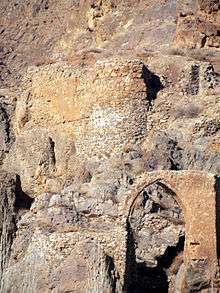


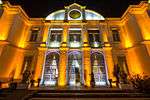

_bridge.jpg)
In the Persian epic, Shahnameh, Mazandaran is mentioned in two different sections. The first mention is implicit, when Fereydun sets its capital in a city called Tamishe near Amol:
بیاراست گیتی بسان بهشت.................... به جای گیا سرو گلبن بکشت
از آمل گذر سوی تمیشه کرد .............. نشست اندر آن نامور بیشه کرد
And when Manuchehr is returning to Fereydun's capital, Tamisheh in Mazandaran (known as Tabarestan), after his victory over Salm and Tur[29]
In the second section, a region called Mazandaran is mentioned in the Kai Kavoos era; it is an area which is mostly inhabited by Div (demons). The legendary Iranian Shah Kaykavoos, as well as the Iranian hero Rostam, each take turn to go to Mazandaran in order to battle the demons.
In a verse from Shahnameh, Zal tells Kai Kavoos: "I heard troubling news that the king is planning to go to Mazandaran"

However, this Mazandaran is not considered identical to the modern province of Mazandaran, and is instead a land to the west of Iran. The current province was simply considered a part of Tabaristan; the name Mazandaran is a later development, perhaps based upon local terminology.[30]
In Gaston Leroux's The Phantom of the Opera, one of the characters was formerly the daroga (chief of police) of Mazanderan.
Culture
Nowruz
The Tabarian New Year, or Neowrez, occurs in the pintek days of the Tabarian Calendar. In the Mazandarani language of Iran in the Mazanderani calendar, the year is divided into 12 thirty-day months and one pentad of days, often beginning on March 21. Neowrez Khani is one of the strongest and most popular traditions of the Mazanderani people.
Ceremonies and Events
Tirgan is a mid summer Iranian festival, celebrated annually on Tir 13 (July 3, 4, or 5). It is performed by splashing water, dancing, reciting poetry, and serving traditional foods such as spinach soup and shole-zard. The custom of tying rainbow-colored bands on wrists, which are worn for ten days and then thrown into a stream, is also a way to rejoice for children. Other famous events like, Varf chal, Traditional ceremony with almost 800 years old as one of the unique rituals of Mazandaran associated with water was held in the village of Ab Ask and Lochu Wrestling game in different time.
Music and Dance
Music in this region relates to the life style of the inhabitants, and the melodies revolve around issues such as the forests, cultivation or farming activities and herding. The most famous dance of this area is the Shomali dance, not forgetting the stick dance that the men perform. Popular music in province, known as the Taleb and Zohre, Amiri Khani and Katuli.
Tourism
Over 15 million Iranian and some 400,000 foreign tourists visit the province annually. More than 800 registered historical and cultural sites, 338 kilometers of shorelines, mineral springs in jungles and mountains, waterfalls, and caves are among the major tourism attractions in the Mazandaran province.
Historical and natural tourist attractions
- Mount Damavand
- Abbas Abad Garden Behshahr
- Tomb Mashhad Mir Bozorg Marashi
- Tomb tower Sayyed Haydar Amuli
- Safi Abad Palace
- Ramsar Palace
- Malek Bahman Castle
- Lajim Tower
- Veresk Bridge
- Castle Poolad Baladeh
- Davazdah Cheshmeh Bridge
- Moalagh Bridge Amol
- Shapour Bridge Juybar
- Bathroom Vaziri Sari
- Tomb Darvish Fakhruddin Babol
- History Museum Amol
- Museum of Babol Amol
- Hot water Larijan
- Shah Neshin Castle
- Lake Valasht
- Lar Dam
- Alam-Kuh
- Lar National Park
- Badab-e Surt
- Tomb of Imamzadeh Abbas
- Kandolus Museum Nowshahr
- Atashkadeh of Amol
- Imamzadeh Ebrahim Amol
- Imamzadeh Ebrahim Babolsar
- Imamzadeh Yahya Sari
- See Sangan
- Abpari Waterfall
- Cave Zangian Qaemshahr
- Alimastan Village
- Shahrak-e Namak Abrud
- Huto and Kamarband Caves
- Cemetery Sefid Chah
- Cheshmeh Kileh Bridge Tonekabon
- Resket Tower Savadkooh
- Waterfall Tircan
- Jameh Mosque of Amol
- Jameh Mosque of Sari
- Elburz Range forest steppe
- Bridge Felezi of Babolsar
- Imam Hassan Askari Mosque
- Lake Miansheh
- Forest Park Nur
- Clock tower Sari
- Haraz River
- Gerdkooh ancient hill
- Mount Takht-e Suleyman
- Waterfall Sangeno
- Heshtel Towers
- Amoloo Mineral Water Spring
- Harijan Village Chalus
- Tamishan Palace Noor
- Div Sefid Cave
- Cemetery Ispe Chah
- Alasht Village
- Cemetery Ispe Chah
- Zangian Cave
- Cheshmeh Imarat Behshar
- Mohammad Hassan Khan Bridge Babol
- Haft Abshar Waterfall Babol
- Hill Qlaya Ghale Kety
- Bathroom Vaziri Sari
- House Kalbadi Sari
- House Manouchehri Amol
- Palace of Shapur
- Temple Kowsan
- Cave rostam Kola
- Garden Chehelsotoon
- Mansion Municipal Tonekabon
- Castle Kanglou
- Tower Shervin Bavand
- Church sourkh Abad
- Watchtower of Babol
- Tomb Shab baloo zahid Amuli
- Heshtel Tower
- Mosque Jameh of Babol
- Mosque Mohadesin
- Tomb of Ibn-e Shahr Ashoob
- Imamzadeh Sayyid Ali kia Sultan
- Tomb of Seyed Mohammad Zarrin Nava
- Herijan Waterfall
- Deryouk Waterfall
- Espe-o Waterfall
- Kiasar Waterfall
- Takieh Taker
- Tower Shervin Bavand
- Lake Sahon
- Forest Park Chaldareh
- Forest Park Shahid Zare
- Forest Park Mirza Kuchik Khan Haraz
- Forst Park Kashpel
- Miankaleh peninsula
- Marko Summit
- Forst Park Dalkhani
- Do hezar Village
- Abe ask Village
- Shahrak-e Darya Kenar
- Lavij Village
- Sheikh Musa Village
- Shoormast Lake Savadkuh
- Forest Sange no Neka
- Amoloo mineral water Springs
- Ramsar mineral water Springs
- Pahlavi Hotel Qaem Shahr
- Band-e Borideh River
- Bazaar of Amol
- Marmar Palace of Ramsar
- Ramsar Hotel
- Clock Tower of Sari
- Waterfall Sangeno
- Cellar Kafer Keli
- Imamzadeh Hashem Haraz
- Waterfall Shahandasht
- Shoormast Lake
- Figure King Haraz
People
People from and/or active in Mazandaran Province or its historical region include:
Literature
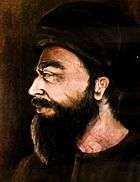
- Muhammad ibn Jarir al-Tabari (838-923), was a Persian world historian and theologian (the most famous and widely influential person called al-Tabari).
- Espahbod Sa'ad ad-Din Varavini [31] who wrote the book called Marzuban-nama, and also a Divan of poetry in the Ṭabarí dialect, known as the Níkí-nama.
- Ibn Isfandiyar, historian, author of a history of Tabaristan (Tarikh-i Tabaristan).
- Mírzá Asadu’llah Fádil Mázandarání (1880–1957), Iranian Bahá'í scholar.
- Musa ibn Khalil Mazandarani, 19th century Persian scribe and scholar.
- Sayyed Zahiruddin Mar'ashi
- Parviz Natel-Khanlari
Poetry
- Nima Youshij
- Mohammad Zohari
- Amir Pazevari
- Taleb Amoli
- Sofi Mazandarani
- Mina Assadi
- Seyed Karim Amiri Firuzkuhi
- Mohsen Emadi
- Salman Harati
- Ciyos Guran
- Faramarz Soleimani
Music
Architecture
- Omar Tiberiades (Abû Hafs 'Umar ibn al-Farrukhân al-Tabarî Amoli) (d.c.815), Persian astrologer and architect.
Cinema
- Shahab Hosseini
- Khosrow Sinai
- Davoud Rashidi
- Kambiz Dirbaz
- Ladan Mostofi
- Mostafa Zamani
- Mohammad Ali Sadjadi
- Anahita Hemmati
- Roya Nonahali
- Irene Zazians
- Reza Allamehzadeh
- Abbas Amiri
- Saba Kamali
- Ardalan Shoja Kaveh
- Parinaz Izadyar
- Maryam Kavyani
- Amrolah Saberi
- Hosein Gil
Portrait
Scholar
History
Science
- Ali ibn Sahl Rabban al-Tabari His stature, however, was eclipsed by his more famous pupil, Muhammad ibn Zakarīya Rāzi.
- Abul Hasan al-Tabari, a 10th-century Iranian physician.
- Abu'l Tayyeb Tabari[32] was jurisconsult, judge (qāżī), and professor of legal sciences; he was regarded by his contemporaries as one of the leading Shafeʿites of 5th/11th century Baghdad.
- Ali Yachkaschi
- Moslem Bahadori
- Iraj Malekpour
- Pooran Farrokhzad
- Shahrokh Meskoob
Philosophy
- Fakhr al-Din al-Razi Theologian and philosopher.
- Ibn Hindu
Physician and astrologer
- Muhammad ibn Mahmud Amuli
- Abū Sahl al-Qūhī
- Al-Nagawri
- Sahl ibn Bishr
- Muhammad ibn Ayyub Tabari
- Yahya ibn Abi Mansur
- Al-Nagawri
- Tunakabuni
- Al-Natili
- Haseb Tabari
Athletics
- Abdollah Movahed
- Imam-Ali Habibi
- Ghasem Rezaei
- Hassan Rangraz
- Reza Yazdani
- Hassan Yazdani
- Reza Soukhteh-Saraei
- Majid Torkan
- Askari Mohammadian
- Abbas Hajkenari
- Mehdi Taghavi
- Komeil Ghasemi
- Morad Mohammadi
- Ahmad Mohammadi
- Mehdi Hajizadeh
- Masoud Esmaeilpour
- Ezzatollah Akbari
- Ali Asghar Bazri
- Behnam Ehsanpour
- Bashir Babajanzadeh
- Reza Simkhah
- Behdad Salimi
- Mohammad Reza Khalatbari
- Farhad Majidi
- Mehrdad Oladi
- Mohsen Bengar
- Rahman Ahmadi
- Hossein Tavakkoli
- Hanif Omranzadeh
- Hadi Norouzi
- Adel Gholami
- Mojtaba Mirzajanpour
- Sheys Rezaei
- Morteza Pouraliganji
- Mojtaba Abedini
- Sohrab Entezari
- Farshid Talebi
- Mousa Nabipour
- Shahab Gordan
- Noshad Alamiyan
- Sousan Hajipour
- Mahmoud Fekri
- Ramin Rezaeian
- Bahador Molaei
- Maysam Baou
- Omid Ebrahimi
- Morteza Mehrzad
- Farzan Ashourzadeh
- Saeid Shiroud
- Reza Ghara
- Shoja' Khalilzadeh
- Omid Alishah
- Hamed Kavianpour
- Kianoush Rahmati
- Hadi Khanarinejad
- Ebrahim Taghipour
- Mohsen Yousefi
- Javad Asghari Moghaddam
- Manouchehr Boroumand
- Jasem Delavari
- Peiman Hosseini
Royalty

- Reza Shah Pahlavi He was the Shah of Iran (Persia) from 15 December 1925 until he was forced to abdicate by the Anglo-Soviet invasion of Iran on 16 September 1941.
- Mohammad Reza Pahlavi
- Dowlatshah
- Khayr al-Nisa Begum
- Khurshid of Tabaristan
Military
Politics
- Ali Larijani
- Mohammad Vali Khan Tonekaboni
- Manuchehr Mottaki
- Ehsan Tabari
- Hossein Ghods-Nakhai
- Noureddin Kianouri
- Ali-Akbar Davar
- Esfandiar Rahim Mashaei
- Hamid Reza Chitgar
- Sadeq Larijani
- Mohammad-Javad Larijani
- Bagher Larijani
- Ali Akbar Nategh-Nouri
- Mirza Aqa Khan Nuri
- Ahmad Tavakoli
- Davoud Hermidas-Bavand
- Sam Dastyari
- Ali Kordan
- Elaheh Koulaei
- Abdul Karim Hashemi Nejad
- Reza Sheykholeslam
- Shamseddin Hosseini
- Hassan Ghashghavi
- Mirza Mohammad Shafi Mazandarani
- Sheikh Khalifa Mazandarani
- Moshir al-Saltaneh
- Mirza Hassan Khan Esfandiary
Christianity
- Hossein Fallah Noshirvani
- Shaban Dibaj
Islamic scholars
- Hassan Hasanzadeh Amoli
- Abdollah Javadi-Amoli
- Mirza Hashem Amoli
- Abd al-Qahir al-Jurjani
- Muhammad Taqi Amoli
- Haydar Amuli
- Ibn Furak
- Ali Asghar Mazandarani
- Mirza Husain Noori Tabarsi
- Muḥammad ibn Ali Ibn Shahrashub
- Shaykh Tabarsi
- Imad al-Din al-Tabari
- Rustam al-Tabari
- Abul-Abbas Qassab Amoli
- Yasubedin Rastegar Jooybari
- Mullah Ali Kani
- Mohaddes Nouri
Other religion
- Daniel al-Kumisi
- Baha'u'llah- The founder of the Baha'i Faith was born and grew up in Nur, Mazandaran
- Quddús
Master
- Kourosh Mansory
- Gholamali Soleimani
- Maria Khorsand
Mazandaran today
Food
Mazandarani cuisine is diverse from a region to another region of Mazandaran. The cuisine of Coastal regions is different from Mountainous regions as people settled in the Alborz usually use the indigenous herbs and coastal people use the dishes of fish and Caspian Mazandaran rice with vegetables. However each people have their own beliefs as they know which dish could be used as remedy for an illness. Every year many of scholars come to Mazandaran province to researching about wild herbs and regional dishes.
Economy
Having Sea, jungle and tourism all together has made the province one of the 5 wealthiest in Iran in terms of GDP and net worth.The recent explored oil resources will make the status even better by attracting new investment in the field. Rice, grain, fruits, cotton, tea, tobacco, sugarcane, and silk are produced in the lowland strip along the Caspian shore. Oil wealth has stimulated industries in food processing, cement, textiles, cotton, and fishing (caviar). Suitable environmental conditions, pleasant and moderate climate, beautiful natural landscapes, and proximity to Tehran, have led the province to be one of the main recreational and tourism areas of Iran. Iran's Cultural Heritage Organization lists close to 630 sites of historical and cultural significance, hence a wealth of tourist attractions. Rice, grain, fruits, cotton, tea, tobacco, sugarcane, and silk are produced in the lowland strip along the Caspian shore. Oil wealth has stimulated industries in food processing, cement, textiles, cotton, and fishing (caviar).
Colleges and universities
Main universities of Mazandaran:
- University of Mazandaran, Babolsar
- Mazandaran University of Medical Sciences, Sari
- Babol Noshirvani University of Technology, Babol
- Babol University of Medical Sciences, Babol
- Sari Agricultural Sciences and Natural Resources University, Sari
- Shomal University, Amol
- Allameh Mohaddes Nouri University
Sports
Wrestling The first exercise province. for the past several years Mazandaran has generated the most consistent stream of dominant wrestlers.[33] Football and Football Two other popular sports that have a lot of players in the Premier League and the national team is. Wightlifting, Martial arts and Taekwondo, Table tennis, Boxing, Kickboxing, Kung Fu, Karate, Rally car other successful sports in province. Kalleh Mazandaran VC and Shamoushak Noshahr F.C. and F.C. Nassaji Mazandaran three famous team in province.
See also
- Tapurian people Mazandarani people.
- List of Mazanderanis
- Maziar
- Alborz (Elburz) mountain range topics
References
- 1 2 همشهری آنلاین-استانهای کشور به ۵ منطقه تقسیم شدند
- ↑ "Province of Mazandaran". Iran Chamber Society. Retrieved 11 September 2016.
- 1 2 Statistical Centre of Iran
- 1 2 Maryam Borjian - Bilingualism in Mazandaran: Peaceful Coexistence With Persian. Archived September 21, 2006, at the Wayback Machine.
- ↑ Based on Maz or Mazan Term: Mazanderani: مازرون Māzerūn, Persian: مازندران, Russian: Мазендеран.
Based on Tapur Term: English: Tapuria, Arabic: طبرستان Ṭabaristan, from Middle Persian Tapuristān
Mazandarani: Tapurana. (not prevalent)
Ancient Greek: Hyrcania came from local name Vergana (Persian Gorgan), Caspia from local name Kaspi, See Caspian Sea. Ferdowsi called the Caspian region Mazandaran, so people refer to Caspian provinces as Gilan.
Note: It was also known as Al-Jannat by the Arabs, meaning paradise, during the 7–8th centuries - ↑ Statistical Centre, Government of Iran. See: "General Characteristics of Ostans according to their administrative divisions at the end of 1383 (2005 CE)" Archived October 26, 2007, at the Wayback Machine. Archived October 26, 2007, at the Wayback Machine., "Population estimation by urban and rural areas, 2005"
- 1 2 University of Mazanderan Archived October 3, 2008, at the Wayback Machine.
- ↑ Census Results, 2006: Sari: 490.830, Babel: 464.535, Amel: 343.747, Shahi: 293.721.
Iranian 2006 Census Website, Information File Archived June 1, 2007, at the Wayback Machine. (in Persian) - ↑ Natural attractions of Mazandaran in IRIB
- ↑ Springer Netherlands; July 10, 2005; Contributions to the knowledge of the useful plants and plant raw materials of Iran; ISSN 0921-9668
- ↑ Mazandaran, Geography & History Archived February 28, 2008, at the Wayback Machine.
- ↑ Encyclopædia Britannica, Entry for Elburz Archived May 3, 2008, at the Wayback Machine.
- ↑ Freshwater Fishes of Iran Archived March 3, 2016, at the Wayback Machine.; Revised: 12 July 2007
- ↑ Encyclopædia Britannica, Entry for Mazandaran
- ↑ (Persian)
- ↑ http://www.sci.org.ir/content/userfiles/_sci_en/sci_en/sel/year85/f1/CS_01_4.HTM[]
- ↑ IRAN Daily Caspian Region Archived September 12, 2007, at the Wayback Machine.
- ↑ Parthia News, November 6, 2005.
- ↑ Payvand, 400 Historical Sites Discovered within 7 Days in Mazandaran Archived March 4, 2016, at the Wayback Machine.
- ↑ CHN Page for Mazandaran
- ↑ Keddie, N. R.; 1968; The Iranian villages before and after land reform. Journal of Contemporary History, 3(3), 69–78.
- 1 2 3 4 5 6 7 8 9 10 11 12 13 14 15 Minorsky, V.; Vasmer, R. "Mazandaran" Encyclopaedia of Islam. Edited by: P. Bearman , Th. Bianquis , C.E. Bosworth , E. van Donzel and W.P. Heinrichs. Brill, 2007. Brill Online.
- ↑ Logan (1992), p. 201
- ↑ Pietro Della Valle, Viaggi, 3 vols. in 4 parts, Rome, 1658–63; tr. J. Pinkerton as Travels in Persia, London, 1811.
- ↑ Gwillim Law, Statoids website. "Provinces of Iran" Archived October 22, 2016, at the Wayback Machine.. Retrieved on 2007-08-28
- ↑ Reference: "The Soviet Socialist Republic of Iran, 1920-1921: Birth of the Trauma" by Cosroe Chaqueri.
- ↑ Gordon, R.G., Jr. (2005). Ethnologue: Languages of the World, 15th edition. (Dallas, TX: SIL International). Online version "Archived copy". Archived from the original on 2016-11-07. Retrieved 2009-11-12.
- ↑ Lars Johanson, Éva Csató, Eva Agnes Csato. The Turkic Languages. Taylor & Francis, 1998. ISBN 0-415-08200-5; p. 274
- ↑ Shahnameh/Book of Kings by Abu'L Ferdawsi, edited by Jalal Khaleghi-Motlagh "Archived copy". Archived from the original on 2014-04-03. Retrieved 2008-08-20.
- ↑ Iran Chamber Society: Geography of Iran: Ancient Iran’s Geographical Position in Shah-Nameh Archived March 3, 2016, at the Wayback Machine.
- ↑ AN ABRIDGED TRANSLATION OF THE HISTORY OF ṬABARISTÁN BY MUHAMMAD B. AL-ḤASAN B. ISFANDIYÁR
- ↑ Encyclopedia Iranica http://www.iranica.com/newsite/index.isc
- ↑ Mazandaran Capital Wrestling
External links
- Official website
- Mazandaran Cultural Heritage Organization
- Official website of Mazandaran TV
- Registration Mazandaran
- A Mazandarani folk-song sung by Shusha Guppy in the 1970s: Darling Dareyne
| Wikimedia Commons has media related to Mazandaran Province. |

